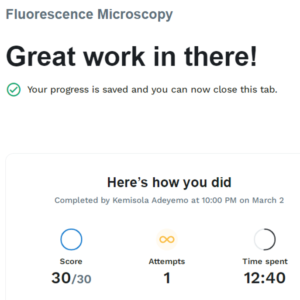COURSE
SCIE1046: Fundamentals Of Microbiology With Lab
1. About the Lab
Learning Objectives:
- Understand the basic principles and practical aspects of fluorescence microscopy.
- Explain the function of different parts of the fluorescence microscope.
- Optimize fluorophore choice.
- Describe the application and limitations of fluorescence microscopy in biology.
- Understand the need for staining.
Estimated Length: 15 to 25 minutes
MAKE THE CONNECTION
The background information in section 2 was adapted from the following Microbiology lecture course Tutorials:
1.1.4 Types and Characteristics of Microorganisms
1.2.1 Light & Lenses of Microscopy
1.2.2 Observing the Microscopic World
1.2.3 Types of Microscopes
1.2.4 Preparing Slides for Microscopy
1.2.5 Staining Methods
1.3.3 Prokaryotic Cells
2. Background Information
The following background information will be helpful as you prepare for the simulation.
Microorganisms are classified and identified based on shared characteristics and evolutionary origins. These classifications have changed over the years with new discoveries. Today, our three main domains of life are Archaea, Bacteria, and Eukarya. Currently, this taxonomy system does not allow for the inclusion of noncellular life, such as viruses and prions. There have been proposals to add a fourth category to include these noncellular organisms, but this has not yet been adopted.
Archaea and Bacteria are all prokaryotic organisms. Prokaryotic organisms are organisms that are unicellular and have no nucleus. Prokaryotes possess DNA, but this DNA floats freely within the cell. All prokaryotes are classified into the kingdom Monera. Monera contains all bacteria including archaebacteria, which are Bacteria that can withstand extreme environmental conditions. Archaea like Bacteria are classified as prokaryotic organisms. However, they have very different genetics. Like bacteria, archaea microbes do not have a true nucleus, and they do possess a cell wall. But unlike bacteria, the cell wall of an archaea microbe is composed of a substance called pseudopeptidoglycan. Archaea can be found in a variety of environments, both extremely hot and extremely cold. Archaea biochemistry more closely resembles eukaryotes than bacteria. Archaea can use both organic compounds and sunlight as energy sources.
Organisms under Eukarya include both unicellular and multicellular organisms that have a nucleus and membrane-bound organelles. These multicellular organisms are referred to as eukaryotes. The DNA in a eukaryote is held within the nucleus.
In general, a prokaryote is ten times smaller than a eukaryote. This is usually because the DNA in a eukaryote is much more complex, and eukaryotes possess organelles. Additionally, prokaryotes possess a cell wall made of peptidoglycan, which is a mixture of amino acids and sugars. Eukaryotes can possess a cell wall, but none are made of peptidoglycan.
Viruses are not classified as prokaryotic or eukaryotic. This is because viruses are acellular. They do not contain a cell. Rather, a virus is a DNA or RNA genetic strand often encased in a series of proteins. Viruses are parasitic, in that they cannot live or reproduce without a host. Viruses survive by inserting themselves on the surface of a living cell. Viruses then insert their genetic material into the cell, overriding the genetic material of the living cell. This causes the living cell to now work on behalf of the virus, completing tasks and replicating the virus’s genetic material. Many viruses do not cause disease, but there are some viruses that are extremely deadly such as influenza. Viruses are the smallest of all microbes and can infect any other living cell including bacteria, fungi, plants, and other parasites.
2a. Fluorescence Microscopes
Fluorescence microscopes use fluorescent chromophores called fluorochromes. These fluorochromes, which can be natural substances or stains, absorb energy from a light source and then release it.
The microscope transmits an excitation light, generally a form of short-wavelength electromagnetic radiation, toward the specimen. The chromophores absorb the excitation light and emit visible light with longer wavelengths. The excitation light is then filtered out (in part because ultraviolet light is harmful to the eyes) so that only visible light passes through the ocular lens. This produces an image of the specimen in bright colors against a dark background.
Fluorescence microscopes are particularly useful in clinical microbiology. They can be used to identify pathogens, to find particular species within an environment, or to find the locations of particular molecules and structures within a cell. Approaches have also been developed to distinguish living cells from dead cells based on whether they take up particular fluorochromes. Multiple fluorochromes can be used on the same specimen to show different structures or features.
TERM TO KNOW
This glossary term is important to know and will help you during the Activity.
Fluorochromes
A fluorescent chromophore. Also called fluorophores.
2b. Types and Characteristics of Microorganisms
You are encouraged to review the complete Microbiology lecture course tutorial 1.1.4 Types and Characteristics of Microorganisms for background on this topic before you begin the simulation.
2c. Light & Lenses of Microscopy
You are encouraged to review the complete Microbiology lecture course tutorial 1.2.1 Light & Lenses of Microscopy for background on this topic before you begin the simulation.
2d. Observing the Microscopic World
You are encouraged to review the complete Microbiology lecture course tutorial 1.2.2 Observing the Microscopic World for background on this topic before you begin the simulation.
2e. Preparing Slides for Microscopy
You are encouraged to review the complete Microbiology lecture course Tutorial 1.2.4 Preparing Slides for Microscopy for background on this topic before you begin the simulation.
2f. Staining Methods
You are encouraged to review the complete Microbiology lecture course Tutorial 1.2.5 Staining Methods for background on this topic before you begin the simulation.
2g. Prokaryotic Cells
You are encouraged to review the complete Microbiology lecture course tutorial 1.3.3 Prokaryotic Cells for background on this topic before you begin the simulation.
3. Lab Manual
Lab Manual – Fluorescence Microscopy
This Lab Manual gives a synopsis of the lab and the theory behind it. You’re encouraged to read or download the manual before launching the lab. This information will also be available during the simulation by selecting the “Theory” tab on the virtual LabPad.
4. Launch Lab
You’re ready to begin! Review the helpful navigation tips below. Then click the Launch Lab button to start your lab. Be sure to answer all the questions in the simulation because they contribute to your score. Good luck, scientists!
- Exiting: To exit a lab simulation, press the ESC key on your keyboard. This key returns you to the objective screen for the simulation.
- Saving: You do not need to complete a simulation in one sitting. Labster saves your progress at predetermined checkpoints upon exit. To see your progress at any time, click on the mission tab of the LabPad.
- Restarting: You are allowed an unlimited number of restarts for a simulation to improve your quiz score. Sophia and Labster will always store your best score.
- Just Browsing: You can restart a simulation to have a look around without completing it. The program will still retain your previous (and best) score.

